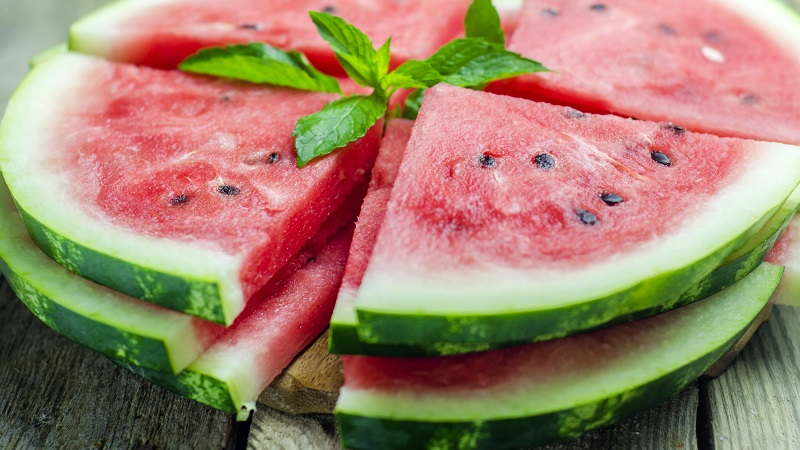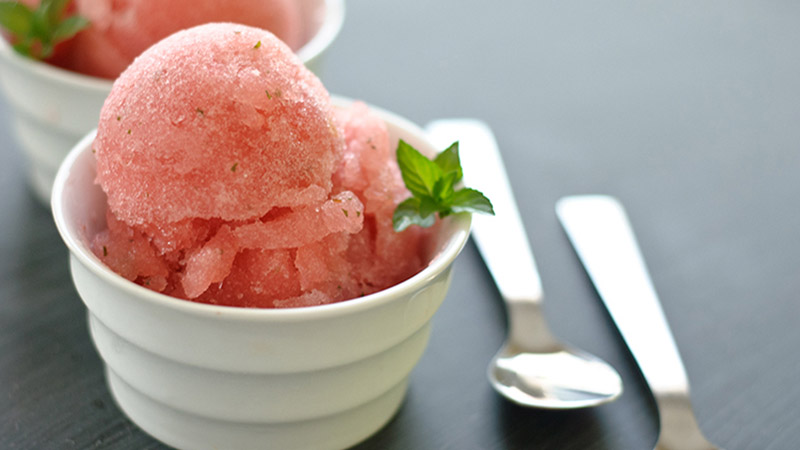Can you eat watermelon for type 2 diabetes?
Watermelons are a favorite treat for children and adults in August and early autumn. In hot weather, they are excellent thirst quenchers, and in autumn they serve as a pleasant reminder of summer days. Watermelons are included in the menu of many therapeutic diets as a low-calorie food with a high water content. Among the diseases requiring a special diet, type 2 diabetes is distinguished.
Nutritionists recommend that diabetics replace sweets and pastries with fruits. So is it possible or not to use watermelon for type 2 diabetes? You will receive a detailed answer to this question in our article. We will consider the composition, calorie content and nutritional parameters of a sweet summer-autumn delicacy.
The content of the article
The composition of the pulp and calorie content of watermelon
Watermelon is considered a dietary product. 100 g of the edible part of the fruit contains 27 kcal.
Nutrient content per 100 g of watermelon pulp:
- proteins - 0.6 g;
- fats - 0.1 g;
- carbohydrates - 5.8 g;
- dietary fiber - 0.4 g;
- water - 92.6 g;
- mineral components - 0.5 g
Fresh watermelon pulp is a source of vitamins, micro- and macroelements.

The content of biologically active substances in the pulp of watermelon (per 100 g of edible part) and the percentage of the daily requirement of an adult are presented in the table.
| Biologically active component | Quantitative content in 100 g of product | % of the recommended daily intake |
| Vitamin A (retinol) | 8 μg | 1 |
| Beta carotene | 100 mcg | 2 |
| Vitamin E (alpha-tocopherol) | 0.1 mg | 1 |
| Vitamin C (ascorbic acid) | 7 mg | 8 |
| Vitamin B1 (thiamin) | 0.04 mg | 3 |
| Vitamin B2 (riboflavin) | 0.06 mg | 3 |
| Vitamin B6 (pyridoxine) | 0.09 mg | 5 |
| Vitamin B9 (folate salts) | 8 μg | 2 |
| Vitamin PP (niacin) | 0.5 mg | 3 |
| Potassium | 110 mg | 4 |
| Calcium | 14 mg | 1 |
| Magnesium | 12 mg | 3 |
| Sodium | 16 mg | 1 |
| Phosphorus | 7 mg | 1 |
| Iron | 1 mg | 6 |
Before including a product in the diet, diabetic patients evaluate not only the carbohydrate content, but also their structure, which affects the glycemic index of the product.
Glycemic Index and Bread Units of Watermelon
The glycemic index is an indicator of the rate at which glucose enters the bloodstream after a meal, that is, the sugar load. Foods containing complex carbohydrates such as starch and glycogen have a low glycemic index. Foods high in glucose, fructose, and disaccharides (sugars) have a high glycemic index.
For type 1 and type 2 diabetes, doctors recommend reducing or eliminating foods with a high glycemic index, rather than high carbohydrates. It is worth figuring out whether watermelon increases blood sugar, and if so, by how much.
Watermelon pulp contains 5.8 g of simple sugars per 100 g, complex carbohydrates do not accumulate in the edible portion of the fruit. A small amount of dietary fiber slightly slows down the absorption of glucose into the blood. The human digestive tract is designed in such a way that the breakdown of carbohydrates and the absorption of glucose begins already in the oral cavity. It is worth biting off a piece of juicy pulp - simple carbohydrates are already beginning to enter the bloodstream.
Glycemic index of watermelon - 65-70 units... The main simple monosaccharide of watermelon is fructose. Under the action of liver enzymes, it quickly converts into glucose and raises blood sugar levels. 100 g of watermelon pulp is equivalent to 1 tablespoon of pure sugar.
An indirect indicator for calculating the rate of consumption of foods with carbohydrates for diabetics is bread units. One bread unit (XE) is equal to 10-12 g of sugar.Watermelon pulp contains 1 XE in 270 g of edible part.
It is important:
Whether or not corn is possible for type 2 diabetes: harm and benefit, consumption rates.
The benefits of watermelon pulp
Watermelon pulp contains 92% water and 0.1% organic acids, which has a positive effect on the genitourinary system and prevents urolithiasis.
During the hot season, drinking watermelons prevents dehydration.
Vitamins and trace elements replenish up to 5% of the daily requirement for these substances when using 100 g of pulp. The average portion of an adult is 300-400 g, it replenishes up to 15-20% of the daily requirement for vitamins and minerals. Such indicators of nutrient content, together with low calorie content, have become the reason for the development of a special watermelon diet for the treatment of obesity.
Attention! Do not go on a diet without the advice of a dietitian. The doctor selects a therapeutic diet based on the biochemical parameters of the blood. Self-change in the diet and exclusion of foods from it can cause irreparable harm to health.
The high water content not only cleanses the kidneys and blood, but also the intestines. To cleanse the intestines and bile ducts, the pulp is salted before use. This method is only suitable for people without a tendency to edema.
What kind of diabetes can you eat watermelon
Diabetes is an endocrine disorder in which the frequency of urination increases and the blood thickens. Thick blood clogs capillaries and blood vessels, which reduces the regenerative function and causes trophic ulcers on the skin and mucous membranes of internal organs. These necrotic tissue lesions are extremely dangerous and fatal.
Diabetes occurs when the pancreas does not work properly (lack of insulin) or the pituitary gland (lack of vasopressin).
In the first case, type 1 and type 2 diabetes are distinguished. In type 1 insulin-dependent diabetes, the hormone insulin is not produced or is produced in an inactive form. This type of diabetes can be hereditary. Patients with type 1 diabetes mellitus are often not overweight and have to take active insulin preparations throughout their lives.
In type 2 diabetes, insulin is produced, but the tissues become insensitive to it. It is a non-hereditary disease caused by metabolic disorders. Patients with this type of diabetes are often overweight and have gastrointestinal problems.
With type 1 and type 2 diabetes, patients are forced to limit their intake of foods high in carbohydrates, including watermelons, as well as other berries and fruits.
A completely different picture is observed in diabetes insipidus caused by a lack of the hormone vasopressin, which increases the reabsorption of water in the kidneys. There are no restrictions on sugar consumption in this disease, and watermelons rich in liquid help temporarily relieve the condition of patients.
Limitations and norms of consumption of watermelons in type 2 diabetes
Due to the high glycemic index, the rate of consumption of watermelon pulp for patients with type 2 diabetes is 300 g per day, provided that all other foods with carbohydrates are excluded from the diet, regardless of their glycemic index.
To slow down the absorption of carbohydrates, nutritionists recommend eating watermelons with whole grain breads or bran. In this case, with diabetes mellitus, you can eat watermelon up to 250 g per day to reduce the sugar load on the pancreas.
It is not recommended for diabetics to drink watermelon juice, as it lacks fiber, which slows down the absorption of fructose.
Beneficial effects when observing the norms of consumption of watermelon pulp:
- the daily calorie content of the diet decreases, it is easier to reduce weight;
- the work of the digestive tract is normalized;
- beneficial nutrients have a beneficial effect on the nervous, cardiovascular and immune systems.
Potential harm is associated with the risk of edema.With a tendency to swelling, concomitant diseases of the respiratory system, with heart or kidney failure, watermelons are completely excluded from the diet.
Watermelons are also not recommended for patients with moderate to high severity diabetes, when taking a pill of a hypoglycemic drug does not compensate for the sugar load on the pancreas.
Choosing healthy watermelons

It is strongly discouraged to buy watermelons at the beginning of the summer season. These appetizing-looking fruits are grown using chemical growth accelerators. These compounds accumulate unchanged in the watermelon pulp. They are not broken down by enzymes of the human body and are dangerous to the health of not only patients with diabetes, but also healthy people.
Depending on the growing conditions, the sugar level in the pulp of the watermelon fluctuates. The more sugary the pulp, the more granular it has. A beneficial watermelon for type 2 diabetics has a non-grainy, watery flesh structure.
It is better to cool the pulp of the watermelon before use. The colder the food, the slower carbohydrates are absorbed into the bloodstream. Watermelon lovers who want to feast on them all winter and spring can freeze watermelon pulp and eat it instead of ice cream.
Low Calorie Watermelon Ice Cream Recipe

Ingredients:
- watermelon pulp - 500 g;
- milk - 250 g (you can use coconut);
- vanilla - 0.5 g;
- gelatin - 10 g (can be replaced with agar-agar or pectin).
The watermelon pulp is peeled from seeds and peels. Milk and peeled watermelons are mixed with a blender until smooth. Gelatin is poured into the mixture and left for 1 hour to swell. The mixture with the swollen gelatin is poured into a metal pan and heated over low heat until the gelatin is completely dissolved. The mixture should not boil.
For even dissolution, it is constantly stirred with a spoon. When the gelatin has completely dissolved, the future ice cream is cooled to room temperature, vanillin is added, poured into molds and placed in the freezer until it solidifies.
Read also:
Why oats are useful for diabetes.
Whether or not eggplant is possible for type 2 diabetes: benefits and harms, recipes.
Why pumpkin is useful for type 1 and type 2 diabetes and how to cook it.
Conclusion
Watermelon pulp is a healthy natural dessert that is rich in nutrients. Due to the high content of easily digestible sugars, it is recommended to limit its intake for type 1 and 2 diabetes to 200-300 g per day. In order not to harm the body, observe the rate of consumption of watermelons and choose fruits with a watery pulp structure.